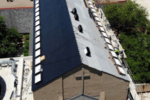March 14, 2024
Reframing Our Assets Blog – Pt. 3
In this new blog series on “Reframing Assets”, we hear how four churches adjusted their thinking about their finances after Covid – reimagining assets, uncovering riches beyond the balance sheet, and charting a new course for ministry. In 2019 these churches shared plans to repurpose assets for ministry. Now, they update us on the critical four years since then, sharing lessons learned, insightful examples, and practical strategies for financial adaptation, asset realignment, and visionary stewardship. Learn how they seek to breathe new life into their community and thrive amidst change.
In 2019, Trinity Cathedral in Portland, OR was looking at ways to put their church spaces to work in service of the community, as reported in a “Vestry Papers” article. In the years since, the congregation has been learning together that stewardship of the church and its finances is community work, engaging the congregation and its neighbors. This post is the third in a four-part series, which has examined how four different congregations have chosen to re-imagine their assets. You can find the other parts of the series here.

What is our true purpose?
Reflecting on that 2019 “Vestry Papers” article, Nathan LeRud, dean of Trinity Cathedral, Portland, OR, reckoned, “We are not where we were four years ago.”
“We have discovered that our building is not the silver key to solve our budget issues,” LeRud said. The congregation’s leadership is questioning whether serving as an events center is the best purpose for the cathedral complex. “Community partner” seems to be a truer identity, as the cathedral’s buildings and grounds serve as a “physical testament to the church’s mission,” as LeRud described it.
The road to reaching that conclusion was, of course, shaped by the Covid pandemic and the recognition that, unlike the cathedrals of Europe, Trinity Portland would not consider itself a tourist destination. Covid restrictions did strongly impact the cathedral’s parking revenue, as downtown traffic and sporting events disappeared. The shift to online worship has provided better access to worship for parishioners who were most affected by the challenges of finding Sunday morning parking nearby, and parking issues are no longer a driving issue in planning.
LeRud considers those realizations a blessing. The cathedral invested six years of discernment and energy preparing to construct an underground parking facility and was on the brink of making significant commitments when Covid changed the conversation.
The challenges of fundraising and budgeting post-Covid led the leadership, for the first time in 15 years, to make a “second ask” for pledge support, when the results of the fall funding campaign made clear that considerable staff cuts would have to be made. “For us, it’s the beginning of a new era,” LeRud remarked, chuckling that “the era of money being talked about by only a few is sooooo over.” LeRud described how his leaders recognized that greater transparency around money matters was essential to building greater trust among constituents. They championed a shift to more robust communication around the cathedral’s finances at all levels – vestry, finance committee, rector’s forums, and ministry meetings.
Imagining a new day
LeRud confesses he hopes to live to see the day when “pledge campaigns” – which have been the norm in American churches for less than 100 years – are no longer considered the method of choice for funding churches. That said, facing the shortfall, while a “gut check,” gave rise to a congregation-wide discussion, generating unanticipated positivity and creativity. The congregation embraced the challenge and exceeded the goal, and members seem to be more invested in the financial well-being of the cathedral. LeRud said that moving forward using that new energy and learning ways of communicating regularly about the cathedral’s financial health, is a goal for the future.
LeRud said that the cathedral’s endowment continues to supply about 25 percent of annual income and that he sensed that “the vast majority of the congregation is unaware or only vaguely aware of the endowment.” Variables in the market over the past four years have prompted the finance committee to begin working to decrease the 5 percent annual draw to 4.5 or 4 percent. “Maybe it’s trust in leadership to manage it prudently, or maybe it’s indifference – either way, it doesn’t seem to be a source of much anxiety … at Trinity.”
“I have a lot of questions,” LeRud concluded, around what congregations truly need a building for, how technology can be used creatively and inclusively to support Christian community, and how gathering the community can be truly life-giving. “I find myself in a mode of running experiments. And learning that when stuff blows up, not to take it personally.”
Adaptive insights
The challenges of a complex church community are many, and maintaining a future focus is always challenging. Trinity’s experiences touch on issues that many congregations face:
- Building a congregation’s trust around leadership, especially in financial matters, is essential to long-term sustainability.
- Transparency, even in difficult situations, is essential and can result in more generous support from the congregation.
- Congregations are wise to invest time and energy in discerning which assets are truly the crux of their well-being.
- Over time, faith communities must embrace the challenge of discerning when a ministry/practice has run its course and needs to give way to a new thing.
- Cultivating your community’s awareness of your endowment can lead to unexpected partnerships as well as gifts.
This post is the third in a four-part series, which has examined how four different congregations have chosen to re-imagine their assets. You can find the other parts of the series here.
Is your church adapting to new financial realities? ECF's Endowment Management team can guide you to reshape your endowment strategy to align with evolving mission and needs. Contact us at endowment@ecf.org or call 800-697-2858 to explore a new vision for your endowment.





